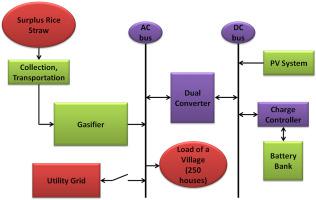Journal of Cleaner Production ( IF 9.7 ) Pub Date : 2021-07-17 , DOI: 10.1016/j.jclepro.2021.128378 Arashdeep Singh 1 , Prasenjit Basak 2

|
In many countries, the farmers find open burning is the cheapest and easiest way for removing large loads of the produced rice straw causing environmental pollution. So, finding a sustainable rice straw management system is need of the hour. In modern hybrid electricity generation systems, the use of rice straw on priority is not evaluated yet. To satisfy this need, this article proposes conceptualization and techno-economic evaluation of a small-scale rice straw based microgrid that processes the surplus rice straw of a village having 250 houses and 900 acres of cultivated land for power generation. The system is capable to process the 1128 tonne/year of 1surplus rice straw and meet the electrical load demand of the same village. The gasification technique is used to process the rice straw, which is further integrated with solar, battery and the utility grid. The optimum size of the microgrid is found using artificial bee colony algorithm. The economic evaluation of the proposed microgrid is organized on the basis of net present cost, annualized system cost and levelized cost of electricity (LCOE). The LCOE of the proposed system is found to be acceptable which is 6.70 INR/kWh (0.089 $/kWh).
中文翻译:

印度情景下基于光伏/生物质的微电网概念化与技术经济评价
在许多国家,农民发现露天焚烧是清除大量生产的造成环境污染的稻草的最便宜和最简单的方法。因此,迫切需要找到一个可持续的稻草管理系统。在现代混合发电系统中,尚未评估优先使用稻草。为了满足这一需求,本文提出了一个基于小规模稻草的微电网的概念化和技术经济评估,该微电网可处理一个拥有 250 套房屋和 900 英亩耕地的村庄的剩余稻草用于发电。该系统能够处理 1128 吨/年的1剩余稻草,满足同村用电负荷需求。采用气化技术处理稻草,进一步与太阳能、电池和公用电网相结合。使用人工蜂群算法找到微电网的最佳尺寸。拟建微电网的经济评估是根据净现成成本、年化系统成本和平准化电力成本 (LCOE) 进行的。发现建议系统的 LCOE 是可接受的,即 6.70 INR/kWh (0.089 $/kWh)。











































 京公网安备 11010802027423号
京公网安备 11010802027423号